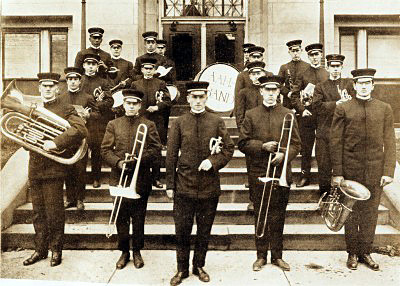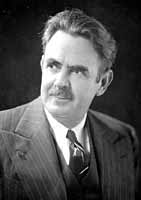Birth of the Band
part 2
Meanwhile, music was flourishing at the U-M, much to the benefit of nearby Ann Arbor High. In 1914, Earl V. Moore of the School of Music set Margaret Cooley's "Purple and White" to music, giving Ann Arbor High its alma mater. (Moore later composed "Push On," the school fight song.) And during the 1913–1914 school year, the first instrumental ensemble of strictly wind and percussion instruments — what we identify as a band — was formed at Ann Arbor High. No doubt it was modeled on popular bands of the day like Sousa's and the local Otto's Band.
The 1914 Omega credits principal W. Merton Aikin with leading the call for players. Eighteen boys were selected, and the new band made its first appearance at the Muskegon football game that fall. "The Band, one of the many things which go to make our school stand head and shoulders above all others, is one of the many new organizations which arouse out of Mr. Aikin's ingenious head, during the past year," the Omega boasted. A picture of the musicians on the front steps of Ann Arbor High commemorates that pioneering group of bandsmen.

The first Ann Arbor High School Band formed in the 1913–1914 school year
The band formed again in the 1914–1915 school year. It marched at football games and the city's Thanksgiving Day Parade and presented a joint concert in the spring with the orchestra and glee club. Perhaps derailed by the US entry into World War I, however, the band then disappeared for another decade.
 It would take a visionary man to re-define the band and make it a permanent fixture at Ann Arbor High School. That man was Joe Maddy, who went on to create the world-famous National Music Camp at Interlochen, and who today is considered by many to be the father of instrumental music in the public schools of America.
It would take a visionary man to re-define the band and make it a permanent fixture at Ann Arbor High School. That man was Joe Maddy, who went on to create the world-famous National Music Camp at Interlochen, and who today is considered by many to be the father of instrumental music in the public schools of America.
Joe Maddy in 1928; photo courtesy of Interlochen Center for the Arts
Maddy was called to Ann Arbor in the fall of 1924 by Earl Moore, who had just become head of the School of Music. With thrifty ingenuity, Moore arranged for Maddy to work half-time as head of music education at the U-M and half-time as music supervisor in the Ann Arbor Public Schools. Maddy's enthusiasm and vision for advancing music education would find fertile ground in Ann Arbor. In his three years at Ann Arbor High, Maddy re-formed the band and orchestra. An innovative instructor, he established the early traditions of musical excellence at the school. Maddy was also a good promoter, persuading the administration to provide funds for instruments and working with the local Rotary Club to purchase new uniforms. Because of confusion with the school administration over course definitions, academic credits, and scheduling, however, the band and orchestra comprised the same students, who would simply play different instruments on different days.
The influence of Joe Maddy and Interlochen on the world of high school music is legendary, but not everybody appreciated his groundbreaking work. In his book Interlochen, A Home for the Arts, Dean Boal relates how Ann Arbor school superintendent Otto Haisley, hired the same year as Maddy, grew increasingly frustrated with his employee's new venture in northern Michigan. Haisley called Maddy "a crazy damn fool" for undertaking "a fool project like the camp" and fired him from the public schools. (Maddy's own version, as told to Verne Collins, was that he resigned so that he could devote more time to the camp.)
